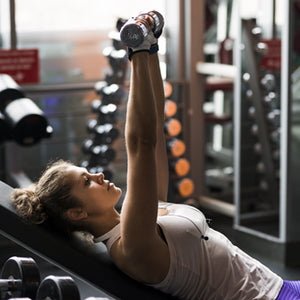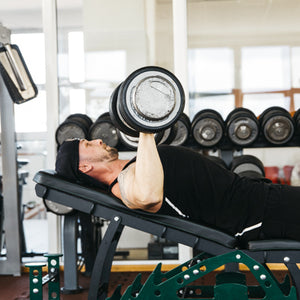
What Does Foam Rolling Actually Do?
Foam rolling is a self-myofascial release (SMR) technique. Essentially, it is the process of using a foam roller (a piece of equipment shaped like a cylindrical tube that is made of compressed foam) to achieve something similar to a deep tissue massage. This practice has been growing in popularity because of its potential to relieve muscle soreness, tightness, and inflammation, as well as increasing mobility and flexibility.
By using a foam roller, you can self-massage any tense muscles or painful knots simply by slowly and carefully rolling over any stiff areas throughout your body. The process of massaging these painful knots or tense muscles (aka trigger points) is generally referred to as "Myofascial Release". "Myo" stands for muscle, and "fascia" refers to the intricate network of connective tissue which runs throughout your entire body. It stabilizes and supports everything from your muscles to your organs. You can think of fascia as a layer of connective tissue fibers that are formed beneath the skin and that spread out throughout your entire body from head to foot.
What is Happening to Muscle Tissue or Fascia When You Foam Roll?
Injury, overuse, or even everyday repetitive use can cause the fascia to become "unhealthy" or "restricted" in certain areas. What foam rolling does, is keep fascia healthy by circulating fresh, oxygenated blood through it. Myofascial release also stimulates nerve fibers that run throughout the body and makes them feel good by relieving pain.
When you foam roll, you are essentially "massaging" out any trigger points or adhesions found in the fascia and helping it return to a healthier and more flexible state. Fascia is supposed to help your muscles move freely and smoothly. When it is restricted, so are your flexibility and your range of motion.
Does Foam Rolling Really Help with Mobility and/or Flexibility?
Fascia can often become stiff or restricted due to injury or overuse. When this happens the area does not have as much flexibility as it could. Foam rolling works out fascial restrictions and adhesions and leads to more flexibility. The same principle goes for improving range of motion (ROM). A "stiff" or restricted section of fascia can be worked on to "loosen" it up and make it more flexible. Foam rolling can achieve this, but a study has found that a combination of foam rolling and static stretching can do even more to improve flexibility.
There have been many studies conducted to try to understand the impact of foam rolling, but until now the studies have been small and somewhat scattered. Although the foam roll effects all appear to be promising and beneficial, the general consensus is that more studies are needed in order to substantiate claims of what foam rolling can and cannot do. Still, there are many people who swear by the benefits of foam rolling.
More Potential Foam Rolling Benefits
- A study has found that foam rolling after exercise has the potential to reduce post-workout muscle soreness. Remember, fascia also has nerve endings, so when the fascia becomes restricted you can experience fascial pain in the same way you would experience muscle soreness. Working on the fascia is as important as working on your muscles to avoid stiffness and discomfort.
- It is widely believed that one of the foam roll benefits is that it helps to relieve back pain.
- Foam roll exercises are showing promising results for treating the symptoms of fibromyalgia.
- Some researchers are looking into whether foam rolling can help to reduce stress and improve sleep.
When is the Best Time to Foam Roll?
When to foam roll is as important as how to foam roll. With foam rolling consistency is key. The general recommendation is that you should foam roll and/or stretch 3-5 times per week. This goes for everyone regardless of where they are on their fitness journey. You can do it more often than that, just be sure not to overdo it and hurt yourself in the process.
The great thing about this practice is that you can see results after foam rolling for as little as one or two minutes. It doesn't have to take up too much of your allocated workout time.
There are massive benefits to foam rolling before AND after working out. When you foam roll before a workout, you increase your tissue elasticity, your range of motion and of course increase your blood flow, all of which helps to protect you from injury as well as simply helping you move better. Foam rolling post-workout is a sure way to get more oxygen to your strained muscles and reduce their recovery time. One great thing about foam rolling is that it is completely customizable, meaning you can work on the muscle groups and areas you focused on during your workout.
Too Much of a Good Thing: Can You Foam Roll Too Much?
As with all things in life, it is very possible to overdo it with foam rolling, or even worse, doing it incorrectly, which can lead to injury. Although the areas you're working on might feel tender while using the foam roller, you should never be in real pain. If it hurts that much chances are you are causing more harm than good.
Remember how we said that with foam rolling consistency is key? Always keep in mind that consistency also trumps intensity with foam rolling. You want to work on a trigger point with a slow and steady approach in order to get the best results.
3 Tips on How to Foam Roll Properly
- Slow and steady wins the race. Take your time while working on a certain area, and be sure to work that area or trigger point slowly and thoroughly.
- Work your way from the ground up. Start with calves, quads, and glutes, and work your way up to your back, shoulders, and arms.
- Remember to breathe deeply. The whole point of foam rolling is to massage that fascia and get fresh oxygenated blood to it. Breathing deeply and slowly will help to remind you to take it slow and relax the muscles you are working on.






